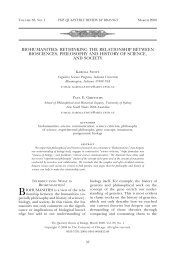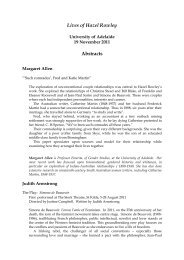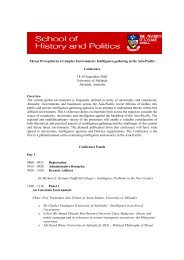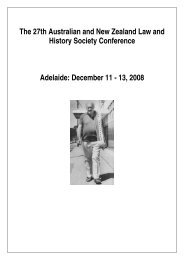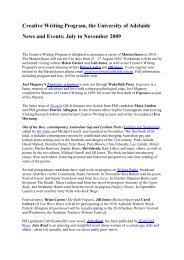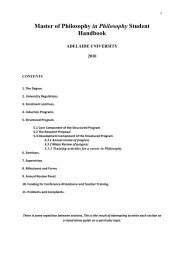Introduction - Faculty of Humanities & Social Sciences
Introduction - Faculty of Humanities & Social Sciences
Introduction - Faculty of Humanities & Social Sciences
Create successful ePaper yourself
Turn your PDF publications into a flip-book with our unique Google optimized e-Paper software.
Introdu ctio n 11<br />
principle. 9 Narrow-sense functions are thus similar to function 5 . Sarkar claims that fitnessenhancing<br />
effects are generally what philosophers <strong>of</strong> biology mean when they talk about<br />
functions.<br />
Finally, Enç and Adams (1992) distinguish between the dispositional and etiological<br />
aspects <strong>of</strong> ‘function’. The dispositional, or forward-looking, aspect <strong>of</strong> function indicates that a<br />
trait or character attributed with this property has a propensity for producing certain types <strong>of</strong><br />
activity that has certain types <strong>of</strong> consequences for the system <strong>of</strong> which it is a part. The key in a<br />
functional account <strong>of</strong> this kind, which equates with function 4 (and resonates with Bigelow and<br />
Pargetter (1987)), is the specification <strong>of</strong> the particular activity that displays the propensity. The<br />
etiological, or backward-looking, aspect <strong>of</strong> function, according to Enç and Adams, relates to the<br />
propensity’s causal history—by natural selection in the case <strong>of</strong> biological functions—and<br />
equates to function 5 .<br />
All five types <strong>of</strong> function in the Mahner-Bunge taxonomy will figure in the following<br />
chapters. However, cognition as function 4 —what cognition contributes to the persistence <strong>of</strong> an<br />
organism—is the main quarry. For the purposes <strong>of</strong> this discussion I will adopt the following<br />
definition <strong>of</strong> function 4 : Feature (subsystem) T has a function in organism (system) O if its activity<br />
contributes to the persistence <strong>of</strong> O, where T is a structure 10 or network(s) <strong>of</strong> processes. An example<br />
<strong>of</strong> how this concept <strong>of</strong> function figures in biological explanation is as follows: “It is well<br />
established that the dentate gyrus <strong>of</strong> the hippocampus is a site <strong>of</strong> neurogenesis in the adult<br />
mammal, but experimental and theoretical explorations <strong>of</strong> the functional significance <strong>of</strong> this<br />
process are just beginning to emerge” (Meltzer, Yabaluri, and Deisseroth 2005:653)(my<br />
emphasis). Here functional significance refers to “cognitive utility” (p.655), namely, how the<br />
generation <strong>of</strong> new neurons in the hippocampus contributes to that brain structure’s wellestablished<br />
role in memory and mood (function 3 ), which are themselves functions that<br />
contribute to the persistence <strong>of</strong> the organism in which they feature (function 4 ).<br />
Although the general approach to cognition adopted here is ‘functional’, it cannot be<br />
emphasized too strongly that this does not entail a commitment to a particular brand <strong>of</strong><br />
functionalism. Functionalism, as an interpretive strategy, comes in many flavours—Thomas<br />
Polger (2004) claims to have distinguished over 100 variations—and is found in a variety <strong>of</strong><br />
disciplines within the humanities and social sciences, including philosophy, psychology,<br />
anthropology, sociology, hermeneutics, and linguistics. 11 Philosophical functionalism, which has<br />
been central to much theorizing in Cognitive Science and philosophy <strong>of</strong> mind over the past half<br />
century, is an explicitly metaphysical thesis about the conditions by which a mental state is<br />
identified in a cognitive system. 12 The core metaphysical commitment is that a mental state is<br />
none other than the role (function) it occupies, which can be specified purely in terms <strong>of</strong> a set<br />
<strong>of</strong> abstract relations linking stimulus conditions with a behavioural response (Putnam 1975;<br />
Wilson 2005; Polger 2004). Cognitive states thus are distinguished by the role they play in<br />
9<br />
In the case <strong>of</strong> etiological accounts, adaptive utillity is why the trait was selected in the past; in the propensity account, it is the reason<br />
the trait will be selected in future.<br />
10<br />
Examples <strong>of</strong> structures include limbs, organs, tissues, and types <strong>of</strong> cells, as well as discernible parts there<strong>of</strong>.<br />
11<br />
Of these, I am most sympathetic to the biologically inspired functionalism <strong>of</strong> pragmatist psychologists such as William James and<br />
the so-called ‘Chicago School’ headed by John Dewey and James Rowland Angell. These functionalist psychologists saw their<br />
approach to psychology as analogous to physiology, in contrast to structuralism (e.g., advocated by Titchener), which they saw as<br />
analogous to anatomy.<br />
12<br />
Polger identifies six types <strong>of</strong> functionalism employed in philosophy: intentional, semantic, theoretical, explanatory, and<br />
methodological, in addition to metaphysical functionalism. However, metaphysical functionalism is the dominant variety and all six<br />
types involve the abstract relation <strong>of</strong> input to output and other mental states. (See Chapter 3 <strong>of</strong> Polger 2004.)




